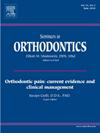Conventional versus digital workflows for palatal TADs?
IF 2.2
4区 医学
Q2 DENTISTRY, ORAL SURGERY & MEDICINE
引用次数: 0
Abstract
Recently the feasibility of modern CAD/CAM workflows were described to manufacture insertion guides and metal printed appliances to improve the possibilities of palatal TAD anchorage. Both conventional and digital workflows are safe and efficacious and broaden the treatment options significantly. Advantages of digital workflow are that TADs and appliance can be inserted in just one appointment, more rigid appliances can be designed and a higher precision can be obtained due to the use of scanners. Disadvantages of the new digital workflow may be higher cost and more time that is needed for the incorporation of digital workflows and design of the appliances. Additionally, there is always need for a laboratory process, whilst some conventional TAD appliances can be bend and adapted directly chairside. Metal printed appliances are very rigid and not flexible and thus cannot be activated or bent easily, which may also be considered as a disadvantage compared to conventional TAD borne sliders.
腭部 TAD 的传统工作流程与数字化工作流程?
本文章由计算机程序翻译,如有差异,请以英文原文为准。
求助全文
约1分钟内获得全文
求助全文
来源期刊

Seminars in Orthodontics
DENTISTRY, ORAL SURGERY & MEDICINE-
CiteScore
2.20
自引率
4.80%
发文量
28
审稿时长
10 days
期刊介绍:
Each issue provides up-to-date, state-of-the-art information on a single topic in orthodontics. Readers are kept abreast of the latest innovations, research findings, clinical applications and clinical methods. Collection of the issues will provide invaluable reference material for present and future review.
 求助内容:
求助内容: 应助结果提醒方式:
应助结果提醒方式:


